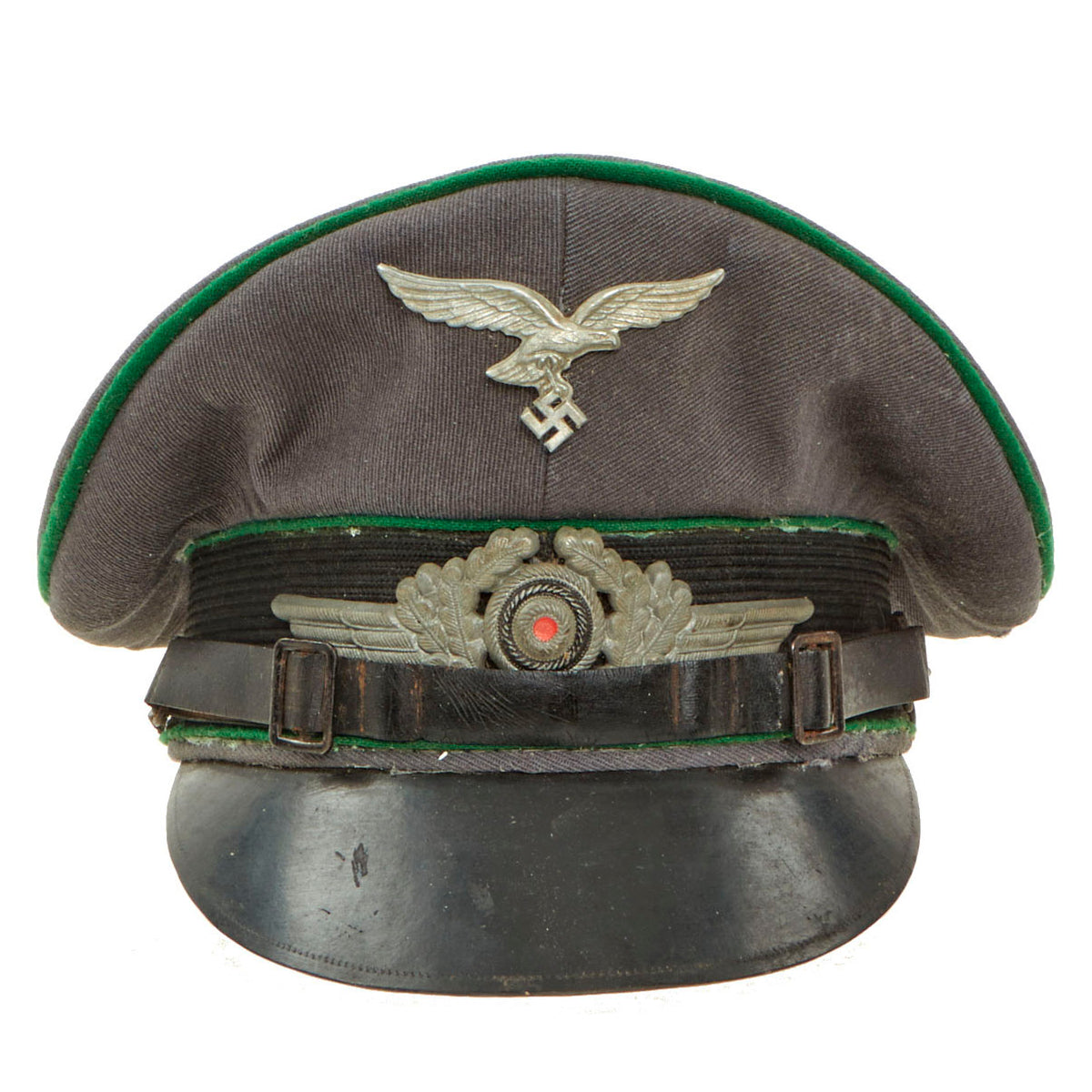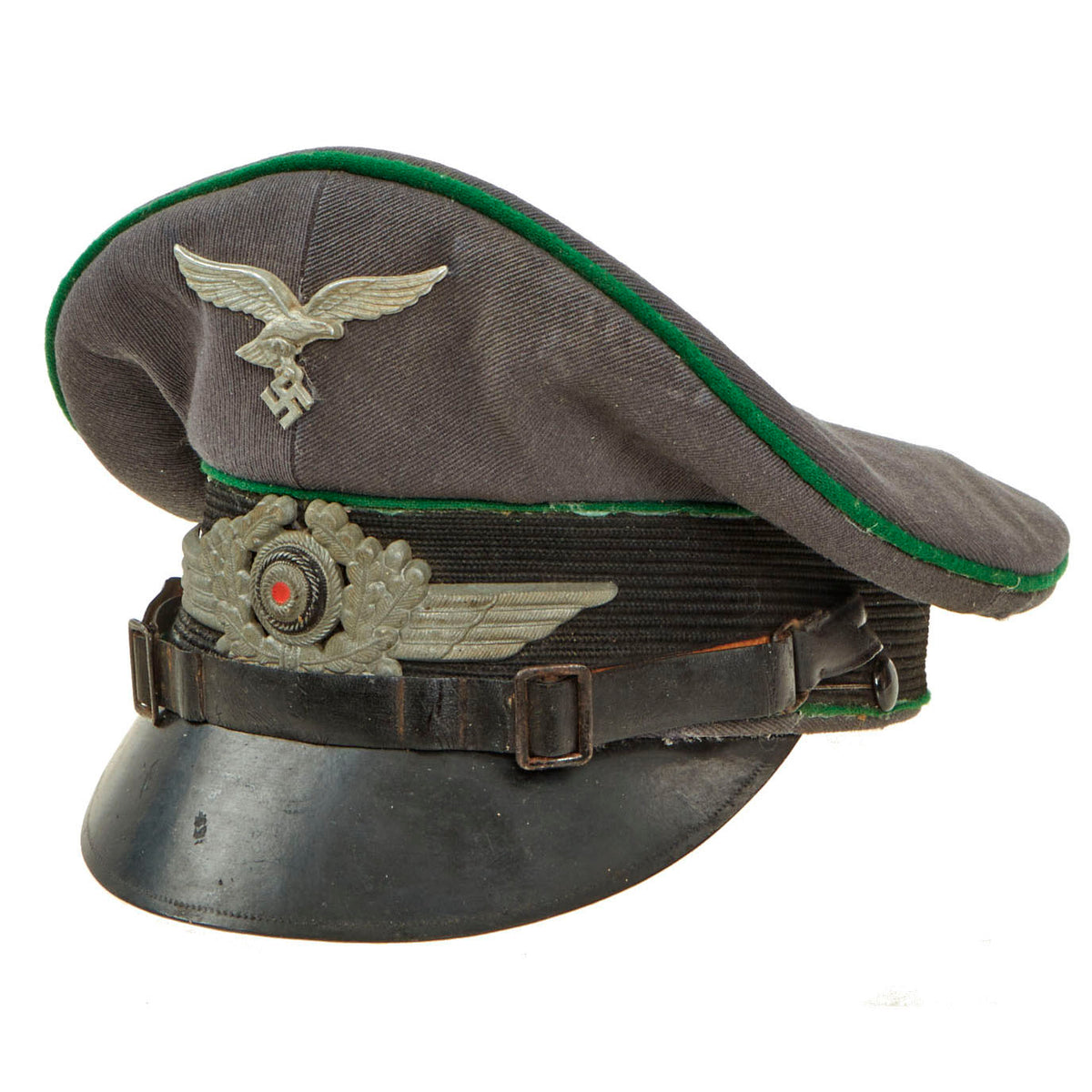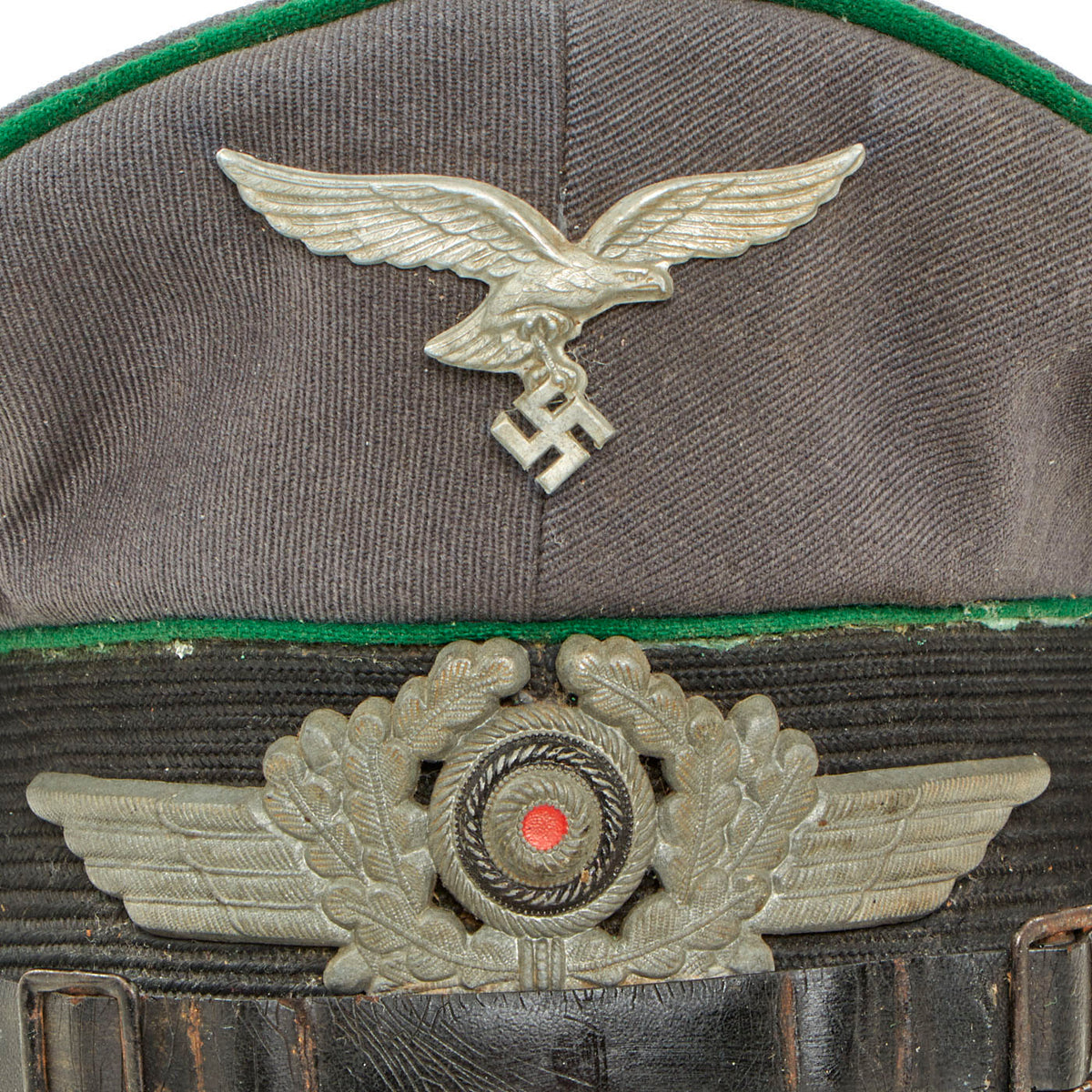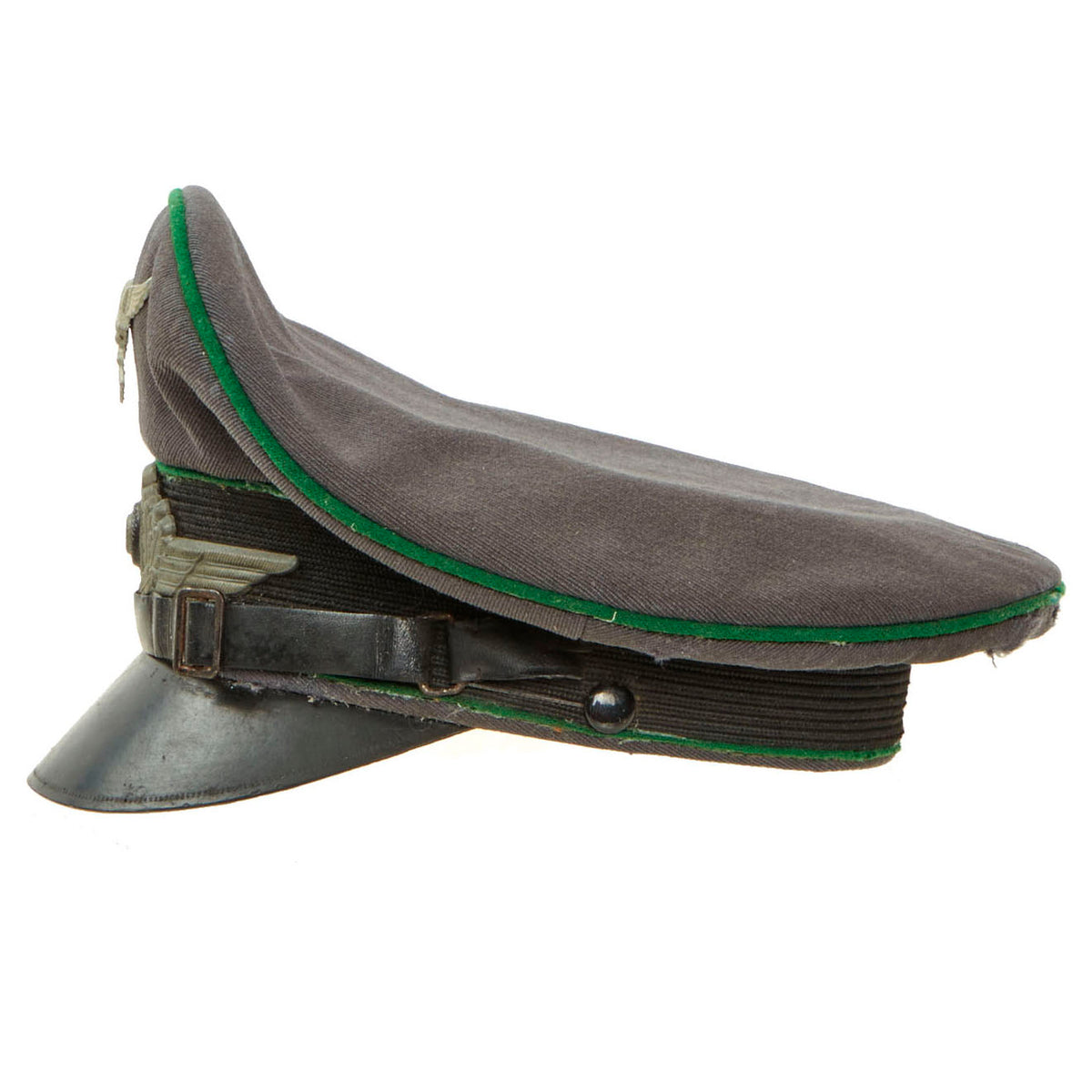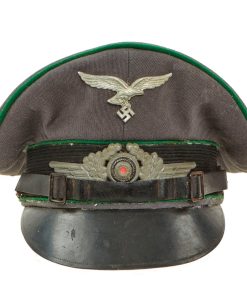Original German WWII Luftwaffe Jäger Field Division Other Ranks Visor Cap Schirmmütze Visor Cap Original Items
$ 795,00 $ 238,50
Original item: Only One Available. Luftwaffe Other Ranks Visor Cap for Luftwaffe Field Divisions. Fabricated in Luftwaffe blue gray Fliegerblau (Flier’s Blue) wool, with a wide black ribbed rayon cap band and traditional high peak. There are three matching rows of Jägergrün (Hunter Green) color piping flanking the band and on the crown, the Waffenfabe (Corps Color) for the Luftwaffe Field Divisions.
It is decorated with a well-detailed silvered aluminum Luftwaffe eagle insignia on the peak and an oak leaf wreath with stylized wings and cockade on the band, the latter in silvered aluminum with a red and black painted cockade and bent on the wings where they meet the wreath on either side. The black smooth finished patent leather chin strap rests upon the visor, composed of three pieces, the central piece with two magnetic metal buckles and joined to the flanking end pieces via rectangular loops, the end pieces attached to black finished magnetic metal buttons on either side. The left side chin strap attachment loop is torn from the button. It appears to have been done while in service and has a “field” repair keeping it attached to the button.
The vulcanfibre visor has a smooth black leather-look upper and has a dark green synthetic underside. Inside of the cap with a sweatband in grayed leather, the ends of the sweatband sewn together where the ends meet at the rear of the cap, but unfortunately is torn.
The condition is great with minor mothing and service wear. A textbook, beautiful example of a rare WW2 German Luftwaffe Field Division visor. Comes ready to display!
Luftwaffe Field Divisions
The divisions were originally authorized in October 1942, following suggestions that the German Army could be bolstered by transferring personnel from other services. The head of the Luftwaffe, Hermann Göring, formulated an alternative plan to raise his own infantry formations under the command of Luftwaffe officers; this was at least partly due to political differences with the Heer. Göring took great pride in the degree of political commitment and indoctrination of Luftwaffe personnel (he went as far as to describe paratroopers of the Luftwaffe as “political soldiers”) while the Army was considered (by NSDAP standards) too “conservative” (linked to conservative or monarchical traditions and ideals harking back to the Imperial days of the Kaiser).
The plan was approved, and the divisions were raised from 200,000 to 250,000 Luftwaffe ground, support and other excess personnel. They were initially organized with two jäger (light infantry) regiments of three battalions each, along with an artillery battalion and other support units, but were substantially smaller than equivalent Heer divisions, and by Göring’s personal order were intended to be restricted to defensive duties in quieter sectors. Most of the units spent much of their existence on the Eastern Front: Luftwaffe Field Divisions were present at actions such as the “Little Stalingrad of the North”, the attempt to relieve Velikiye Luki; the attempted defense of Vitebsk during Operation Bagration, and the fighting in the Courland Pocket, though they also fought in other theaters.
The Luftwaffe Field Divisions initially remained under Luftwaffe command, but late in 1943 those that had not already been disbanded were handed over to the Heer and were reorganized as standard infantry divisions with three two-battalion rifle regiments (retaining their numbering, but with Luftwaffe attached to distinguish them from similarly numbered divisions already existing in the Heer) and Army officers.
Until taken over by the Heer (and in many cases for some time afterwards) these units were issued with standard Luftwaffe feldblau uniforms, and being so easily identifiable were said to often be singled out by opposite forces. Their reputation as combat troops was poor, despite the high standard of Luftwaffe recruits, at least in part from being required to perform roles (ground warfare) for which they as airmen usually had little training. An exception to the poor combat performance of Luftwaffe ground troops were fallschirmjäger (paratrooper) units, whose performance was generally good, due to better training and higher entrance standards when compared to the Field Divisions (early fallschirmjäger troops were also transferred directly from the Heer to the Luftwaffe). Field Division airmen were frequently used for rear echelon duties to free up front line troops.
The German Schirmmütze Visor Cap:
The visor cap (Schirmmütze) was an important part of the headgear worn by German uniformed military, civil, paramilitary and political organizations during the Third Reich. This was the standard cloth headgear worn as a part of the service uniform. Visor caps were worn outdoors as well as indoors, and were often required to be worn by all personnel on duty. Visor caps were made in versions specific to each organization and were often further differentiated through the use of insignia, colored piping, or style of chin cord, to indicate rank, role or branch. The insignia used on these caps ranged from simple stamped metal emblems, to elaborate hand embroidery.
Visor caps were issued to enlisted soldiers and NCOs in the military and in some other organizations. Officers had to purchase their own hats, and lower ranks could choose to purchase caps that were of a higher quality than the rather basic, issued examples. The private purchase caps were generally made in very high quality, with fine materials. A wide variety of fabrics were used, from Trikot and doeskin, to heavy wool, or even lightweight white fabric for summer wear. In the military, issue of these caps was generally suspended shortly after the outbreak of the war, but they continued to be worn by some troops until the end of the war.
Fast Shipping with Professional Packaging
Thanks to our longstanding association with UPS FedEx DHL, and other major international carriers, we are able to provide a range of shipping options. Our warehouse staff is expertly trained and will wrap your products according to our exact and precise specifications. Prior to shipping, your goods will be thoroughly examined and securely secured. We ship to thousands clients each day across multiple countries. This shows how we're dedicated to be the largest retailer on the internet. Warehouses and distribution centres can be located throughout Europe as well as the USA.
Note: Orders with more than one item will be assigned a processing date depending on the item.
Before shipping before shipping, we'll conduct a thorough inspection of the items you have ordered. Today, the majority of orders will be delivered within 48 hours. The delivery time will be between 3-7 days.
Returns
The stock is dynamic and we cannot completely manage it because multiple stakeholders are involved, including our factory and warehouse. So the actual stock may alter at any time. It's possible that you may not receive your order once the order has been made.
Our policy is valid for a period of 30 days. If you don't receive the product within 30 days, we are not able to issue a refund or an exchange.
You can only return an item if it is unused and in the same state as the day you received it. You must have the item in its original packaging.
Related products
Uncategorized
Australian WWII Owen MK1 Machine Carbine SMG Custom Fabricated Replica with Sling Original Items
Uncategorized
Uncategorized
Uncategorized
Uncategorized
Uncategorized
Uncategorized
Uncategorized
Uncategorized
Uncategorized
Uncategorized
Uncategorized
Uncategorized
Uncategorized
Uncategorized
Armored Burgonet Helmet & Polearm from Scottish Castle Leith Hall Circa 1700 Original Items
Uncategorized
Uncategorized
Uncategorized
